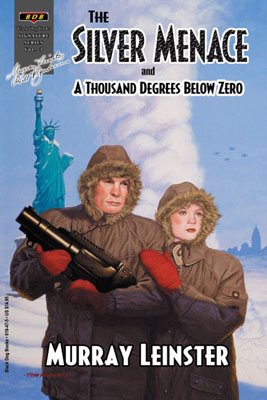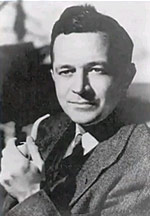
 The Silver Menace
The Silver Menace
and
A Thousand Degrees Below Zero
by Murray Leinster
Black Dog Books
(2007, Tpb, 120 pp., $14.95)
Reviewed by Dave Truesdale
Many of SF’s now legendary icons began their early careers writing for the pulp magazines. They wrote not only for the science fiction pulp magazines–which genre was finally given a name with the April 1926 issue of Hugo Gernback’s Amazing Stories–but for many another title before there even was an “official” science fiction magazine. Early pulp writers would pound the typewriter at lightning speed, cranking out stories for the detective or mystery pulp magazines, or perhaps for the romance or western or adventure magazines at a penny a word if they were lucky, or for those numerous pulps who catered to a general audience and sought all types of stories for their publications–including stories with a scientific rationale that would later be classified as science fiction.
One such early pulp writer was Murray Leinster. Murray Leinster was the pseudonym of Will F(itzgerald) Jenkins (1896-1975). Before he turned 20 Leinster had sold his first story, “The Foreigner,” to H. L. Mencken’s Smart Set in 1916. He would sell quite regularly to this magazine over the next several years, and began to sell to a plethora of other pulp magazines of the time as well, including magazines catering to the western, romance, jungle, and detective audiences, and stories to the detective genre’s most famous pulp Black Mask. When Weird Tales began publishing in 1923, Leinster’s stories would soon appear in its hallowed pages. He was a consummate professional and could write for any market.
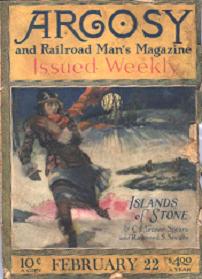
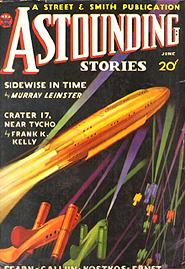 Leinster’s “The Runaway Skyscraper” first appeared in the February 22, 1919 issue of Argosy, and was then reprinted in the June 1926 issue (the third) of Amazing Stories. It is credited as being his first science fiction story.
Leinster’s “The Runaway Skyscraper” first appeared in the February 22, 1919 issue of Argosy, and was then reprinted in the June 1926 issue (the third) of Amazing Stories. It is credited as being his first science fiction story.
Leinster is best known in the science fiction community (when he is remembered at all these days, which is most unfortunate) for perhaps three classic stories. “Sidewise in Time” was published in the June 1934 issue of Astounding Stories, and was the first tale to theorize the possibility of “parallel worlds,” or worlds existing at the same time as the one in which we live, but somehow existing on another plane and in which history took a slightly different turn. It is akin to what we now regard as the Alternate History yarn. Steven H Silver — who created and maintains the Murray Leinster website — also created the Sidewise Awards in the story’s honor in 1995 for the best Alternate History story of the year (both novel and short length), and anyone wishing to learn more of this neglected master would do well to visit the site.
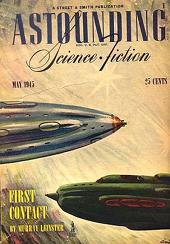 The second, chronologically, of Leinster’s three most famous stories is “First Contact,” which saw print in the May 1945 issue of Astounding Science Fiction. It is perhaps Leinster’s most famous story and was honored by inclusion in the landmark volume The Science Fiction Hall of Fame (ed. Robert Silverberg, 1970). It tied for fourth place with Theodore Sturgeon’s “Mirocosmic God,” and only three stories, as voted by the members of the Science Fiction Writers of America, received more votes (Isaac Asimov’s “Nightfall,” Stanley G. Weinbaum’s “A Martian Odyssey,” and Daniel Keyes’ “Flowers for Algernon”).
The second, chronologically, of Leinster’s three most famous stories is “First Contact,” which saw print in the May 1945 issue of Astounding Science Fiction. It is perhaps Leinster’s most famous story and was honored by inclusion in the landmark volume The Science Fiction Hall of Fame (ed. Robert Silverberg, 1970). It tied for fourth place with Theodore Sturgeon’s “Mirocosmic God,” and only three stories, as voted by the members of the Science Fiction Writers of America, received more votes (Isaac Asimov’s “Nightfall,” Stanley G. Weinbaum’s “A Martian Odyssey,” and Daniel Keyes’ “Flowers for Algernon”).
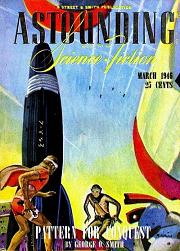 The third in Leinster’s classic triumvirate is perhaps the greatest instance of SFnal prognostication in science fiction history. “A Logic Named Joe” appeared in the March 1946 Astounding Science Fiction. Aside from the terminology employed to describe the internet (after all this was written just after World War II), Leinster nails it with uncanny accuracy. Centralized servers (“tanks”) connecting the individual computers (“Logics”) in every home, the ability to research any subject or topic by pushing a few buttons, email, entertainment programs, a new avenue for wrongdoing by those clever enough to exploit it–Leinster imagined it all, thought it through with unerring accuracy, and was professional enough to write a crackling good story around his idea to boot. An absolute must-read and a story that completely boggled Isaac Asimov even decades after its publication.
The third in Leinster’s classic triumvirate is perhaps the greatest instance of SFnal prognostication in science fiction history. “A Logic Named Joe” appeared in the March 1946 Astounding Science Fiction. Aside from the terminology employed to describe the internet (after all this was written just after World War II), Leinster nails it with uncanny accuracy. Centralized servers (“tanks”) connecting the individual computers (“Logics”) in every home, the ability to research any subject or topic by pushing a few buttons, email, entertainment programs, a new avenue for wrongdoing by those clever enough to exploit it–Leinster imagined it all, thought it through with unerring accuracy, and was professional enough to write a crackling good story around his idea to boot. An absolute must-read and a story that completely boggled Isaac Asimov even decades after its publication.
But these are stories written by a much-matured author, an author writing in his late 30s into the decade of his 50s, a dedicated writer who had written hundreds of stories (and many novels) in a variety of genres, who had supported himself with his writing since his very early 20s. But every burgeoning writer must start somewhere and most writers’ first struggling efforts–with the rare exception–are necessarily less than polished compared to their later work. This was true of Murray Leinster. Though prolific from his early first sales while barely into his 20s, and full of the rich inventiveness and worked-out detail which would characterize much of his best later work, many of his first efforts left a lot to be desired in the realm of line by line, technical craft.
Two such examples are collected for the first time anywhere since their initial magazine appearances in Black Dog Books’ 2007 release, The Silver Menace and A Thousand Degrees Below Zero. Publisher Tom Roberts is but one of an ever-growing number of those doing a great service, not only for the science fiction and fantasy reader, but for all those who love reading exciting tales of yesteryear from any genre, by digging into archives and researching and bringing to light once again forgotten, overlooked, or early work by many a classic pulp magazine author. They are to be commended and enthusiastically supported.
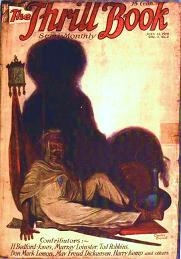 “A Thousand Degrees Below Zero” saw print in the July 15, 1919 issue of The Thrill Book. The book’s rear cover blurb sums the story up nicely: “A mad genius threatens to freeze Earth’s waterways unless he is acclaimed emperor of the planet. Only a clever young scientist, Teddy Gerrod, and a brash aviator, Lt. Richard Davis, dare to defy his deadly ‘cold bombs’ in a brave battle to preserve the world’s freedom.”
“A Thousand Degrees Below Zero” saw print in the July 15, 1919 issue of The Thrill Book. The book’s rear cover blurb sums the story up nicely: “A mad genius threatens to freeze Earth’s waterways unless he is acclaimed emperor of the planet. Only a clever young scientist, Teddy Gerrod, and a brash aviator, Lt. Richard Davis, dare to defy his deadly ‘cold bombs’ in a brave battle to preserve the world’s freedom.”
The novelette also includes an older scientist and his lovely daughter Evelyn, the charming love interest for the young, handsome Teddy Gerrod, who become engaged at story’s end. The mad genius who seeks to blackmail Earth into total surrender by shutting down its major waterways by freezing them solid with his scientifically created cold bombs–for which the science of the time has no answer–forms the simple plot. The chemical details of how the bombs are created and work are well thought out, as are the details of early airplane flight, and the problems to be overcome after a solution is discovered and an air battle with the mad genius (in his converted-for-battle dirigible) is at hand. It is this attention to detail and problem-solving with the fate of the world in the balance that keep the reader engaged. The downside is the crude, forced, prose. Some sentences are overlong and loaded with commas, and otherwise awkwardly constructed. One can see the author straining for the proper word choices, some glaringly out of place. The ellipses between scenes are sometimes confusing or abrupt, not properly introduced or set up–all beginner’s mistakes. Nevertheless, Leinster keeps the dialogue, action, and plot moving quickly, setting his heroes one deadly obstacle after another to be puzzled out and overcome, with the classic time deadline of imminent disaster forcing the pace of the story to its rousing conclusion.
It must also be said that Leinster’s treatment of the love interest here is a cut above the expected, especially for the time period, as the older scientist’s lovely daughter Evelyn is not just a pretty face swooning for the hero, but a scientist in her own right whose smarts help defeat the mad genius, Wladislaw Varrhus. Crudely written, it yet reveals the young author has the talent to compose a fast-paced, entertaining tale, one in which he has done his homework in chemistry and aerodynamics, and knows how to combine them into a publishable story.
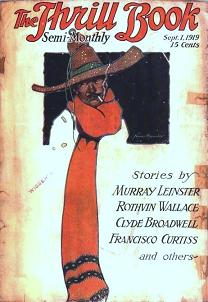
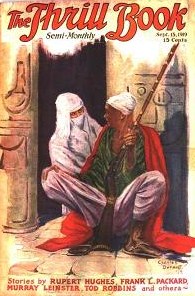 “The Silver Menace” also saw print in The Thrill Book as a short two-part serial. The first installment ran in the September 1, 1919 issue, the conclusion in the September 15, 1919 issue. A sequel to the above story, here Leinster turns to biology to anchor his tale. A hitherto unknown marine organism of miniscule size appears off the eastern coast of the United States. It reproduces at a fantastic rate and threatens at first the ocean, then the coast itself, crawling up the waterways and slowly creeping over solid ground. The “animalcules” as they are called, are tiny thinly-shelled creatures, silvery in color, with groping octopoid-like tentacles. As a large group they have the consistency of thick jello, and feed on just about anything (think an ever-insatiable Blob composed of millions upon millions of small marine creatures).
“The Silver Menace” also saw print in The Thrill Book as a short two-part serial. The first installment ran in the September 1, 1919 issue, the conclusion in the September 15, 1919 issue. A sequel to the above story, here Leinster turns to biology to anchor his tale. A hitherto unknown marine organism of miniscule size appears off the eastern coast of the United States. It reproduces at a fantastic rate and threatens at first the ocean, then the coast itself, crawling up the waterways and slowly creeping over solid ground. The “animalcules” as they are called, are tiny thinly-shelled creatures, silvery in color, with groping octopoid-like tentacles. As a large group they have the consistency of thick jello, and feed on just about anything (think an ever-insatiable Blob composed of millions upon millions of small marine creatures).
The story opens aboard a yacht off the eastern coast of the United States, where steamship magnate Alexander Morrison and his lovely, witty daughter Nita are vacationing. When their progress is halted by the creeping Silver Menace a distress call is placed. Back on land our heroes from “A Thousand Degrees Below Zero” are brought in to investigate and rescue the stranded Morrison, his daughter, and the crew. Again, the rear cover blurb offers a concise summary: “An ecological disaster turns the oceans into masses of muck and unleashes a creeping doom on all mankind. Once again the team of Gerrod and Davis becomes the world’s last hope as these heroes strive desperately to defeat the Silver Menace.”
The plot is similar to the previous Gerrod and Davis adventure, in that they must first discover just what the Silver Menace is, then find a way to defeat it. As in the previous tale, Leinster provides several obstacles to be overcome before the Silver Menace engulfs major parts of the east coast, killing thousands as it creeps relentlessly over the landscape. Again, he does his biological homework, providing an interesting series of speculations based on the science of the time, and from which our intrepid crew of scientists (Gerrod, Evelyn, and her father) derive their battle plans. Following several valiant but failed attempts–and while the creeping menace grows ever more dangerous to human life, among whom is the steamship magnate now holed up in his house, surrounded entirely by the Silver Blob–an answer is finally found, but can they save Alexander Morrison in time? Well, of course they can, and do, but Leinster is learning how to ratchet up the tension though we know the outcome, and he does it to full effect here.
As in the first tale presented in this volume, this one ends on an upbeat note, with a romantic conclusion. Remember Nita, the steamship magnate’s available daughter? She is so grateful that her father has been saved that, along with the success of the scientists involved, she is also very grateful to the former World War I pilot, now free-lance adventurer Richard Davis for his role in her father’s rescue. Though Davis and Nita are in love and wish to marry, the protocols of the time dictate that they must procure the father’s blessing. Which is a high hurdle, for Mr. Morrison is sure that, like many another of his daughter’s past suitors, Davis is only after her for the money he will marry into. Needless to say, all’s well that ends well (with Evelyn’s help), and now both of our heroes are happily paired up.
For all practical purposes written at the same time as “Ten Thousand Degrees Below Zero,” “The Silver Menace” comes across as a smoother, slightly more polished effort, as if the author was learning his craft with each new story. Still relatively rough, to be sure, but showing a line-by-line technical improvement, we again are pleased with the author’s research and how he makes it come alive in the story.
Both stories are prime case studies in how a young, immature writer–albeit one with a vivid imagination and the wherewithal to research his subject matter, along with the rudimentary skills of basic storytelling–evolves. The writing skills would soon match the raw storytelling verve, as anyone who has read the later Leinster’s classic tales will testify. But the raw skills and energy shine through in these pair of early, never-before-reprinted stories. They prove Frank M. Robinson’s astute insight when he commented: “Good writing will seldom sell a bad story, but a good story will frequently sell bad writing.”
Thanks go to Tom Roberts and his Black Dog Books for sharing these forgotten early tales from one of science fiction’s great talents, a talent now almost forgotten to all but SF insiders. Murray Leinster’s career would span more than 50 years, for he continued to write and sell nearly until his death in 1975. He would win a Hugo Award for Best Novelette in 1956 for his story “Exploration Team” (Astounding, March 1956), a long 40 years following his first professional sale to Mencken’s Smart Set, and the fan press would name him “The Dean of Science Fiction” in the mid-1960s, an approbation the New York Times included in his obituary.
